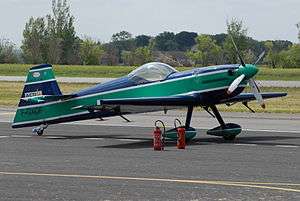Mudry CAP 230
| CAP 232 | |
|---|---|
 | |
| CAP-232 at Airexpo 2007 | |
| Role | Competition aerobatic aircraft |
| Manufacturer | Avions Mudry & Cie (now Apex Aircraft) |
| First flight | 1997 |
| Introduction | 1998 |
| Primary user | Moroccan Air Force |
| Developed from | Mudry CAP-20 |
The CAP Aviation CAP-23x family is a family of aircraft designed for competition aerobatics. The CAP 230 airframe was a direct development of the CAP 21 competition single seater strengthened to cope with a 300 hp 6-cylinder Lycoming AEIO-540 engine instead of the 200 hp original 4-cylinder Lycoming AEIO-360.
Design and development
The CAP 230 was primarily developed in 1985 for the French Air Force. From the basic CAP 21 airframe, trailing edge apex triangular surfaces were added to the basic trapezoidal wing. The CAP 230 keeps a full wooden construction and certified to cope with +10/-10 G-forces.
The CAP 231 was developed in 1990. The fuselage design remained unchanged and only leading edge triangular apex surfaces were added to reduce buffeting during high G pullups. The CAP 231 was world champion in 1990.
To increase performance, in 1991, a carbon-fiber wing taken from an EXTRA 260 (thus the -EX name) was adapted to a few CAP 231 airframes.
The CAP 231EX evolved in 1994. While the fuselage construction retained wood, a carbon-fiber wing was specially designed for durability and light weight. The design has won the World Championships in 1998, 2000 and 2007, as well as a number of other national-level competitions. With a roll rate of 420° per second and a climb rate of nearly 3,300 feet per minute, the CAP-232 is still well suited for the aerobatic circuit.
The CAP 232 just like the -230 and -231/-231EX were slightly modified to strengthen the fuselage structure after a fatal accident in 2005 which grounded them for a full year. Fuselage rib n°2 holding the landing gear and the wing spar has been reinforced externally and internally. The planes are now back to competition and came second (individual with a -231EX), sixth with a -232, and first team at the WAC 2007. After 20 years, the basic CAP 230 airframe is still competitive.
Operators
Military
 Morocco
Morocco- 8 aircraft, flown by the Royal Moroccan Air Force air display team Marche Verte
 France
France- The French Air Force aerobatic team owned CAP 230, 231 and 232
Civilian
Airclubs and privates own planes of all subtypes.
Specifications (CAP 231)
Data from Jane's All The World's Aircraft 1993–94[1]
General characteristics
- Crew: one
- Length: 6.75 m (22 ft 1¾ in)
- Wingspan: 8.08 m (26 ft 6 in)
- Height: 1.90 m (6 ft 2¾ in)
- Wing area: 9.86 m2 (106 sq ft)
- Airfoil: V16F
- Empty weight: 630 kg (1,389 lb)
- Loaded weight: 730 kg (1,609 lb) (aerobatic)
- Max. takeoff weight: 820 kg (1,807 lb)
- Powerplant: 1 × Lycoming AEIO-540-L1 B5D air-cooled flat-six, 224 kW (300 hp)
Performance
- Never exceed speed: 400 km/h (216 knots, 248 mph)
- Maximum speed: 330 km/h (178 knots, 205 mph) at sea level
- Cruise speed: 300 km/h (162 knots, 186 mph) (75% power)
- Stall speed: 90 km/h (49 knots, 56 mph)
- Range: 360 km (194 nmi, 223 mi)
- Rate of climb: 16 m/s (3,150 ft/m)
- Wing loading: 74.0 kg/m2 (15.2 lb/sq ft)
- Power/mass: 0.31 kW/kg (0.19 hp/lb)
- G-loads: +10; -10g
- Roll rate at 300 km/h (161 knots, 186 mph): 270 degree/s
- Fuel: 65 L (14.3 Imp.gal, 17.2 US gal)
See also
- Aircraft of comparable role, configuration and era
References
External links
![]() Media related to CAP Aviation aircraft at Wikimedia Commons
Media related to CAP Aviation aircraft at Wikimedia Commons